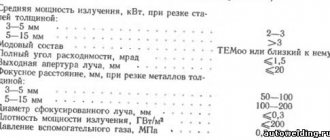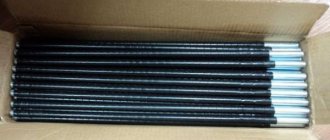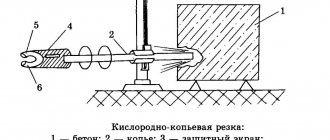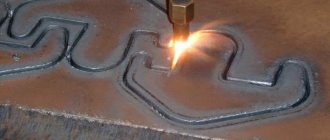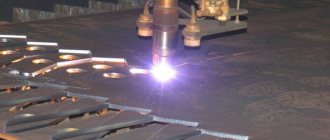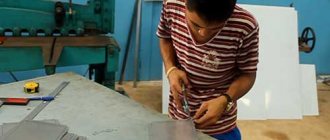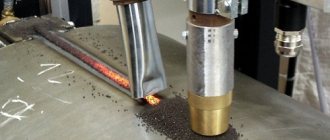Oxygen-flux separation cutting is a separation cutting method in which powdered flux material is introduced into the cutting area. Due to this, the amount of heat released during cutting increases and refractory oxides are deoxidized. As a result, it is possible to cut thick-walled rolled metal, castings, slabs, as well as concrete and reinforced concrete products.
Essence of the process
At the moment of formation of the oxygen stream, flux, most often iron powder, is slowly and continuously supplied. When burned, the powder releases the necessary additional amount of heat, thereby increasing the cutting temperature range. This method allows the formed oxides not to harden. Oxygen cutting using flux is used for:
- • high-alloy steels containing chromium and nickel, the components of which during the welding process form refractory oxides that are not eliminated by an oxygen jet;
- • work with cast iron and non-ferrous metals that are sensitive to temperature fluctuations.
Types of fluxes - iron and aluminum powders, quartz sand, silicocalcium and ferrosilicon - ceramic fluxes (for low-alloy steel), ferrophosphorus (for cast iron).
Gases for plasma cutting of aluminum
High-quality cutting of non-ferrous metals is obtained as a result of plasma cutting. The plasma with which aluminum and its alloys are processed is formed through the use of inactive gases: hydrogen, argon or nitrogen.
Active gases, such as air and oxygen, are used to work with ferrous metals.
Cutting aluminum with gas using a plasma cutter is possible with a workpiece thickness of no more than 70 mm.
Gas mixtures containing nitrogen and argon are not suitable for working with aluminum, since they are intended for processing high-alloy steels 50 mm thick.
Types of oxygen-flux cutting
Oxygen-flux cutting technology processes metals with the pressure of a gas flame mixed with a stream of oxygen, which performs the function of a “cutting flame.” In this way, cutting durable metals can be done both manually and mechanically. For automatic oxygen-flux cutting, gas-cutting devices are used in which cutters are installed. Using the machines, the master can make surface cutting or separation. When cutting manually, special holders are used, in which gas and oxygen are also supplied under pressure. Both manual and machine methods can process high-strength metals up to two hundred millimeters thick at high speed (about 300-700 mm/min).
Pereosnastka.ru
The essence of the process and equipment for oxygen-flux cutting
TO
category:
Oxygen cutting technology
The essence of the process and equipment for oxygen-flux cutting
In the oxyfuel cutting process, metal burns at a temperature below its melting point. If the melting temperature of the oxides formed during combustion is higher than the melting temperature of the metal, then conventional oxygen cutting of such metals becomes impossible. For example, when cutting chromium steels, chromium oxides are formed with a melting point of 2270 °C, while chromium melts at a temperature of 1903 °C. The same applies to nickel and other metals.
The refractory film of oxides prevents contact between the metal heated to the ignition temperature and the oxygen stream. Heat removal from adjacent areas of the metal increases, a stream of oxygen cools the cut site and the cutting process stops.
Metals whose oxidation produces a refractory film include corrosion-resistant (stainless), heat-resistant (scale-resistant) and heat-resistant steels, cast iron, copper, aluminum and their alloys, etc.
For successful oxygen cutting of these metals, it is necessary to ensure the melting and transfer of the resulting refractory oxides into slag. This can be done due to additional heating of the cut site from the combustion of flux.
The essence of oxygen-flux cutting is that powdered flux is introduced to the cutting site (into the cut slot), along with cutting oxygen and a heating flame.
The flux supplied to the cutting zone performs two functions: thermal and abrasive.
The thermal effect of flux is that it burns in the cut gap, as a result of which the temperature of the cut site increases, refractory oxides become liquid and are easily removed under the influence of gravity and pressure of the oxygen jet. Using flux, it is possible to cut metal up to 500 mm thick.
The injected flux forms slag from combustion products in the cut gap. This slag transfers its heat to the lower layers of the metal being cut, the lower layers of the metal are additionally heated to the ignition temperature and the depth of cut increases.
The essence of the abrasive effect of flux is that its particles, which have high speed, erase refractory oxides from the cut surface by impact friction.
Flux compositions. To release additional heat during cutting, iron powder is mainly used as a flux. When iron powder burns, low-melting iron oxides are formed, which, fused with the oxides of the surface film, form more low-melting slags, which are relatively easily removed from the cut zone.
A stable process for cutting stainless steels occurs when the iron powder contains up to 0.4% carbon and oxygen (in the form of oxides) up to 6%. An increase in the carbon and oxygen content in iron powder reduces the temperature in the cut zone and deteriorates the quality of its surface, increasing powder consumption.
In accordance with GOST 9849-74, five grades of iron powder are used: PZH 1, PZH 2, PZH 3, PZH 4 and PZH 5, respectively containing at least 98.5 iron; 98.0; 98.0; 96.0; 94.0; other impurities: carbon, silicon, manganese, sulfur and phosphorus.
In addition to iron powder, various mixtures of it with other components are used. For example, when cutting chromium-nickel steels, the greatest efficiency is obtained by adding 10-15% aluminum powder to the iron powder. When this mixture is burned in oxygen, low-melting slags with a melting point of less than 1300 °C are formed. Slag is easily blown off during surface cutting if up to 20% silicocalcium (23-31% Ca, 62-59% Si, 1.5-3% Al, etc.) is added to the iron powder.
Devices for oxygen-flux processing of metals
Processing of metal products using the oxygen-flux method is carried out using special devices. The design of the device includes such elements as a cutter, a flux feeder, and a flux transmitter into the cutter. The metal-cutting tool in the device has a larger diameter compared to a similar device for cutting only with oxygen. Oxidizers, propane, nitrogen, flux-carrying gases, and CO2 act as combustible raw materials. The spear holder “KD-1” helps in the manual cutting process. Machine cutting with flux and oxygen is carried out on portal automatic devices and UKFR-6M installations. Devices for manual and automatic cutting process materials such as steel, cast iron, concrete, aluminum, and various non-ferrous alloys.
The process of oxygen-flux cutting of high-chromium steels
Products made of high-chromium and chromium-nickel steel cannot be treated with oxygen alone due to the fact that, when oxidized, chromium becomes refractory and is difficult to remove from the cut of the workpiece. For such materials, oxygen-flux cutting technology was invented. Steel blanks with a high chromium content are cut with a stream of oxygen to which powder (flux) has been added. The powder substance burns when it comes into contact with oxygen, the heat output increases, and the chromium steel begins to melt exactly at the cutting points. Working using this technology produces a clean cut surface.
Oxygen-flux cutting of cast iron
Cast iron products melt at very high temperatures, so the oxygen fluxing process is also used for cast iron. Oxygen cutting is not suitable due to the fact that cast iron contains silicon, which forms a durable film under the influence of CO2. You can melt it to get a neat cut on the product only with the addition of flux powder. Oxygen-flux cutting of cast iron prevents contamination of the oxygen stream and prevents oxidation from occurring at the cut sites.
Gas for laser cutting of aluminum
When laser processing of metals, 4 types of auxiliary gases are used:
- oxygen, which is an active gas;
- nitrogen, classified as conditionally inert;
- argon and helium are truly inert;
- atmospheric air.
However, laser cutting of aluminum is performed using conditionally inert nitrogen, which participates in chemical reactions but is not an oxidizing agent. And when working with most metals, specialists try to prevent oxidation and combustion reactions.
In addition to the fact that nitrogen does not enter into oxidation reactions in the cut area, it displaces oxygen-containing atmospheric air from it. Thus, O2 also does not cause oxidation of the cut edges.
Oxygen when cutting aluminum with gas negatively affects the quality of processing, preventing you from obtaining clean and even cut edges. When cutting aluminum with O2, you can get uneven edges with many burrs. Some time ago it was used for cutting aluminum, since more powerful equipment did not exist. Then the uneven edges of the products were processed mechanically, improving their quality. However, additional mechanical processing increased the time spent on production and, accordingly, increased the cost of the finished product.
Currently, more powerful equipment is used; the use of nitrogen allows you to immediately obtain a high-quality cut that does not require further processing of the edges. This gas is suitable for cutting aluminum, stainless steel, high alloy steel, and nickel.
Oxygen-flux cutting of non-ferrous metals
The difficulty of processing non-ferrous metals (such as brass, bronze, copper alloys) is the high thermal conductivity of these materials. Oxygen does not generate enough heat to cope with non-ferrous metal parts. Cutting non-ferrous metals with oxygen and flux is done by adding a substance - ferrophosphorus - to the powder. In addition, the cutting process begins only after preheating to 300-400 degrees Celsius. When working with oxygen-flux technology, craftsmen wear respiratory masks, since the substances released during the process are harmful to humans.
No less popular methods of cutting aluminum with plasma and laser
- Laser cutting.
This type of cutting requires a laser resonator that excites a narrow beam with a wavelength of the required length. The beam is directed to the designated cutting line and melts the metal of the workpiece due to the energy concentrated in it.
The advantages of cutting aluminum with a laser are:
- high performance;
- the ability to obtain parts of the required size and configuration without further modification;
- no deformation of cut edges;
- the ability to create products of various, including complex, configurations.
This method is used when it is necessary to make holes of complex shapes in workpieces, maintaining precise tolerances and fits. Due to the lack of contact with the metal being processed, it does not deform during the cutting process. The essence of the treatment is the transmission of pulsed laser radiation excited using a fiber, gas or carbon dioxide laser system.
- Plasma cutting.
To create a plasma flow, ionization of gas supplied under pressure by an electric arc is used. Ionized gas (hydrogen, nitrogen, argon) is heated to several thousand degrees Celsius. Aluminum and other metals are subjected to a short-term high-temperature effect; molten particles are removed from the cut zone instantly.
The advantages of plasma cutting of aluminum are:
- efficiency;
- ability to cut metals with a thickness of 200 millimeters or more;
- high performance;
- a wide range of processed metals and alloys;
- excellent quality of products;
- the possibility of producing products with complex configurations - both in mass production and according to individual drawings.
When cutting aluminum and other metals with gas, the choice of gas is made based on the thickness of the workpiece being cut: less than 20 mm - nitrogen is used, less than 100 mm - a mixture of nitrogen with hydrogen, more than 100 mm - a mixture of argon and hydrogen.
